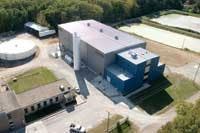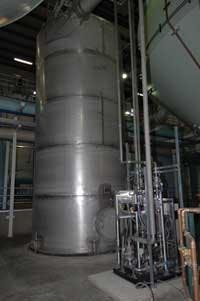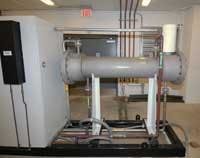Management at the new 4.5 mgd surface water treatment plant (SWTP) in Charleston, IL, reports it has established future opportunity for disinfection credits, while ending a 25–year taste and odor problem, by installing a special ozone generation and treatment system. The state of Illinois does not currently recognize ozone as a disinfectant.
“We had eventual petitioning for disinfection credits in mind when we built this plant,” said Bill Bosler, Charleston’s water treatment superintendent, “but our official objective for the ozone system in the new plant was to solve our long–running taste and odor problem. Meanwhile, the state required a one–year pilot ozone system study at the old plant while the new plant was under construction.
“The results have been phenomenal. We have not received one single taste or odor complaint since the ozone system was installed in January 2006. Previously, we would have an average of 18–30 complaints per month from July to October, and then another two or three each month the rest of the year.”
The ozone generators were manufactured by Mitsubishi Electric Corp. of Kobe, Japan, with system design, installation, and ongoing service provided by its subsidiary, Mitsubishi Electric Power Products Inc. (MEPPI) of Warrendale, PA.
MEPPI also helped the city and its consulting engineering firm conduct the pilot study.
“The ozone system vendor helped form ID protocols for the pilot study, and provided a comprehensive review of ozone’s impact on the city’s water as it would be treated in a full–scale plant,” said Jim Roth, P.E., project manager for the Charleston ozone system and manager of business development for Crawford Murphy & Tilley Inc. of Springfield, IL, the city’s consulting engineers for the project. “Our firm got involved to get the full–scale project accomplished within the city’s budget.”
“To accommodate the possibility of a future petition for disinfection credits, the ozone system vendor set up the filters as bio–active, in such a way as to control operational byproducts,” he continued. “There’s a dual backwash in the design to accomplish that.”
“They also built in appropriate contact time for the ozone to allow for disinfection, and established the system as redundant to greatly enhance its reliability, as well as allow for flexible and economical operation. It’s much easier to control something at 75% of capacity than at 40%, including assuring you’re not overfeeding ozone.”
“The Illinois Environmental Protection Agency (IEPA) has a history of being conservative with changes to regulations,” Roth noted, “which is not a bad thing in a state that has a tremendous variety of treatment systems. They have to be careful how they craft regulations in order to cover different types of situations. Charleston may do a very good job, but it’s hard to generalize for all cases. In time, the disinfection issue will work itself out, and when it does, this city will be prepared.”
The 4.5 mgd, cone–style SWTP has a lime softening process that uses an upflow clarifier. It came on line in April 2005, and has run at an average of 1.9 mgd, with peak at 2.7 mgd and low at 1.2 mgd. It replaced a plant built in 1964 that could no longer meet a change in the IEPA turbidity requirement from 0.5 NTU to 0.3 NTU, 95% of the time.
“That was a source of major complaints for 25 years,” Bosler said. “Our 350–acre reservoir has an average depth of only 8 feet, and major summertime algae blooms resulted in taste and odor degradation. To fix the problem over the years with the old plant, we tried powdered activated carbon, potassium permanganate, and chlorine dioxide, but nothing would do the job 100% of the time. We put ozone treatment out to bid as part of the new plant, and finally got the reliable solution we needed.”
With the new plant, a pump station at the reservoir moves raw water to the head tank, where a cationic polymer is injected with liquid alum. Lime is added in two, 36 ft. diameter cones, before movement by gravity flow to the carbonation tank and ozone contact tank. The ozone–treated flow is pumped to four, 18 ft. decelerating flow filters, each of which has a 5 ft. bed of granular activated carbon and a 2 ft. bed of sand.
Fluoride and sodium hypochlorite are injected before entry to the ribbon–flow, 400,000 gallon clearwell. At the high service pumps, a final dose of sodium hypochlorite is added with ammonia before the flow is pumped to the distribution system.
“The ozone system vendor we selected had by far the superior presentation, and they were very knowledgeable and helpful throughout the pilot study and full–scale project,” Bosler said. “The only previous ozone installation we knew of in Illinois had been placed at the raw water pumping station. Ours was the first in the state to be put in the center of the treatment train. There’s no need to kill stuff your normal process is going to remove.”
To counter taste and odor sources of algae, Geosmin, and methylisoborneol (MIB), MEPPI recommended ozone concentrations of 1–3 ppm in the contact tank. Previously in the train, the water receives 4 ppm of cationic polymer, 25 ppm of alum, 150 ppm of lime, and 3 ppm of CO2. Following the ozone contact tank, it is treated with 1 ppm fluoride, a first chlorine dose of 1.5 ppm, and a final chlorine dose of 3 ppm, with 2 ppm of ammonia.
The ozone system includes a 1500 gallon liquid oxygen storage tank, a vaporizer to produce gaseous oxygen, and two 100–lb./day, 10% ozone–by–weight generators. An ozone pump injector skid introduces the ozone into the contact tank. The system occupies a footprint within the plant’s main building of 37 ft. x 26 ft., plus a separate building outside on a footprint of 20 ft. x 30 ft.
From the contact tank, unused ozone is brought back for reduction to oxygen and release to the atmosphere. The system also includes two 25–gal./min. water chiller units, and a nitrogen–boost skid to supply a small amount of nitrogen during the ozone generation process.
“One of the main issues we had heard about with other ozone systems was with the dielectric tubes,” Bosler said. “Maintenance guys were having to pull them out frequently for cleaning, and when they did, often found them broken. This vendor assured us we wouldn’t have to touch those tubes for at least 10 years. Meanwhile, we have a 3–year maintenance contract with them, which covers biannual checking of ozone generation and concentration levels, and changing filters in the oxygen system.”
To help assure continuous delivery of ozone for disinfection, the ozone generators feature patented, self–healing dielectric tubes designed to allow for continued operation of the dielectric surface during failure of a segment. The borosilicate glass dielectric is described as a patented design that resists thermal shock, and evenly distributes the applied electric charge over the entire dielectric surface without arcing. It allows the remainder of a tube to continue ozone production during failure of a segment, which would otherwise cause the HV fuse to rupture, or the inverter to shut down.
Mitsubishi Electric Corporation has manufactured ozone systems since 1968. Its wholly–owned subsidiary Mitsubishi Electric Power Products Inc. (MEPPI) was established in the U.S. in 1985 to provide applications engineering and service support for a broad range of its products.
MEPPI has offered ozone systems since 2000, including special engineering resources for applications in the water industry that covers all generating and ancillary equipment and its automation. More information can be found on the company’s website, www.meppi.com






